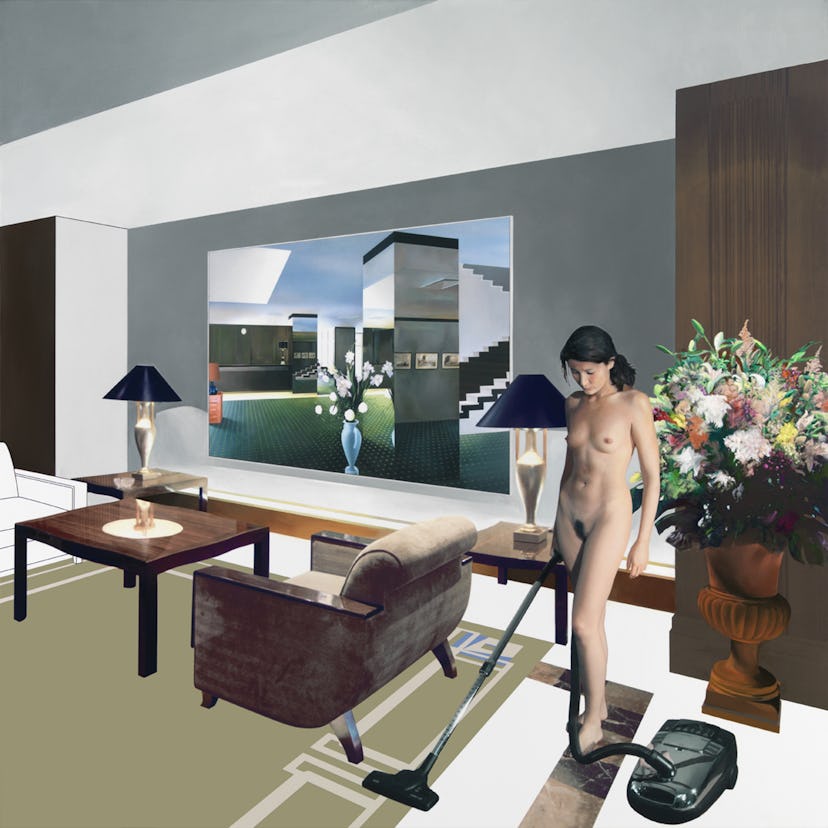Richard Hamilton

It has been said that the term “Pop Art” was coined by the British artist Richard Hamilton when, in 1957, he dashed off a short, sharp list of its qualities: “Pop art,” he concluded “is sexy; gimmicky; glamorous; big business.” Hamilton, who died in 2011, also gave us Pop’s seminal work, What is it that makes today’s homes so different, so appealing?, his 1956 collage of the body builder and glamour girl whose lusciously pumped bodies echo the curvy goods that fill their dream apartment.
His most famous creation, however, is The White Album, the stark white sleeve design that he created for The Beatles in 1968. Yet as the retrospective of his work now on at the Tate Modern in London makes clear, Hamilton’s take on consumer culture was a long way from the blank, shiny surfaces that have fascinated Pop’s most famous sons, Warhol and Koons.
Take, for example, My Marilyn (1966), Hamilton’s version of Pop’s ultimate pin-up. It features a contact sheet from the famous beach shoot that took place shortly before her death, which the star had herself marked up, indicating where her body needed to be retouched. In one frame Monroe’s vulnerable bikini-clad body has been painted over, reduced to a white silhouette against a toxic puce, pink and lilac backdrop.
Hamilton though was hardly humourless and his many of his works have a sure feel for Pop’s libidinal pulse. Swingeing London 67, his painting based on a paparazzi shot of Mick Jagger and the art dealer Robert Fraser in handcuffs following a 1967 drug bust, sums up the clash between establishment values and the new hipster generation. It’s one of the decade’s defining images.
Meanwhile, in Hamilton’s 1969 Fashion Plate series, advertising’s tendency to reduce people to parts gets a comedy-horror treatment. Against a pristine white photography studio backdrop, made-up eyes with spidery lashes, curled hair and full lips are collaged into a series of pouting Frankenstein’s monsters.
A politically-minded polymath who followed Duchamp’s dictum to never repeat, Hamilton moved on from Pop in the 1970s, depicting a Christ-like Bobby Sands, Tony Blair as a cowboy, and even returning to eerily immaculate interiors haunted by nudes. Though the subject matter, methods and materials varied hugely, Hamilton’s humanist vision remained. Whether it was designer furniture, a fashion shoot, or cocktail glasses, he insisted on putting people before the superficial sheen.
Richard Hamilton is at the Tate Modern, London, through May 26, 2014, tate.org.
Photos: Richard Hamilton
“Just what is it that makes today’s homes so different, so appealing?” 1956, reconstructed in 1992. Copyright the estate of Richard Hamilton.
“Self-Portrait 13.7.80 a 1990.” Copyright the estate of Richard Hamilton.
“Swingeing London 67 (f),” 1968-9. Copyright the estate of Richard Hamilton.
“The Saensbury Wing,” 1999-2000. Copyright the estate of Richard Hamilton.
“Hotel du Rhône,” 2005. Copyright the estate of Richard Hamilton.
“My Marilyn,” 1965. Copyright the estate of Richard Hamilton.
“Fashion-plate (Cosmetic Study V),” 1969. Copyright the estate of Richard Hamilton, courtesy of Simon Dickinson, London.
“Fashion-plate (Cosmetic Study II),” 1969. Copyright the estate of Richard Hamilton.
“Fashion-plate (Cosmetic Study III),” 1969. Copyright the estate of Richard Hamilton.
“An annunciation (a),” 1994–2004. Copyright the estate of Richard Hamilton.
“Bathroom – Fig. 2,” 1999-2000. Copyright the estate of Richard Hamilton.